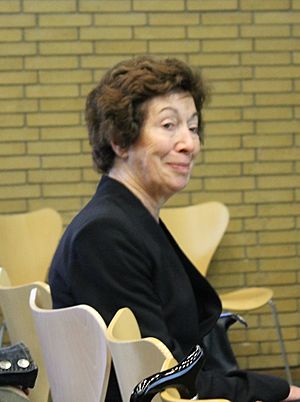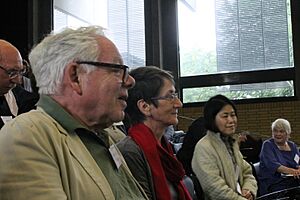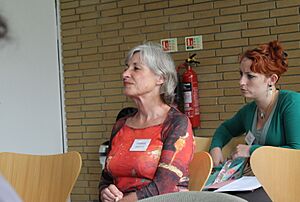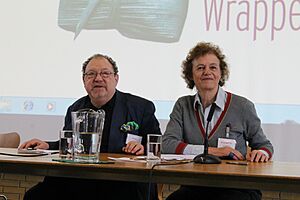Oxford Symposium on Food and Cookery facts for kids
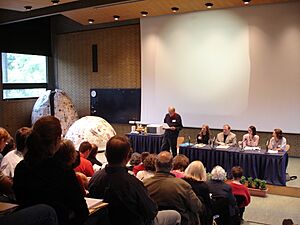
The Oxford Symposium on Food & Cookery is a yearly meeting where people who love food and its history get together. It's a weekend event where experts like academics, food writers, and cooks discuss interesting topics about food studies and food history.
Contents
- What is the Oxford Food Symposium?
- How did the Symposium Begin?
- Early Symposia: Cookery Books and National Styles
- Symposia in the 1980s: Food in Motion and More
- Symposia in the 1990s: From Feasts to Fish
- Symposia 2000-2005: Memory, Meals, and Wild Food
- Recent Symposia at St Catherine's College (2006-2020)
- Published Symposium Books
What is the Oxford Food Symposium?
This special meeting has happened every year since 1983. After each event, the discussions and papers are published in a book about a year later. Since 2006, the Symposium has been held at St Catherine's College, Oxford. It became a charity in 2003. The Oxford Symposium is the oldest yearly meeting of its kind in the world, making it very important in the field of food studies.
The Oxford Symposium is a registered charity in Britain. It has a group of well-known Trustees who help guide it, and there's also a support group called "Friends of the Oxford Symposium."
How did the Symposium Begin?
The idea for the Symposium started with a series of three talks in 1979. These talks were about science and cooking. They were organized by Alan Davidson, a scholar and former diplomat, at St Antony's College, Oxford. He was helped by Theodore Zeldin, a historian. About twenty people attended each talk.
The first talk, on May 4, 1979, was called "Food and Cookery: the Impact of Science in the Kitchen." People from many different fields, like the history of medicine and mathematics, joined in. Nicholas Kurti, a physics professor from Oxford, was there. Even famous cookery writer Elizabeth David attended, though she wasn't sure about the academic approach to food. Other notable attendees included David's publisher Jill Norman, Anne Willan, Paul Levy, and Richard Olney.
The second talk, a week later, focused on 19th-century food chemistry. They discussed books like Friedrich Accum's Culinary Chemistry (1821) and the writings of Justus Liebig. The third meeting was a general discussion about cookery books through history. During this meeting, Elizabeth David shared a rule: it takes at least 25 years for a new dish to go from being cooked to being written down in a recipe book. Claudia Roden joined the group for the second talk. By the third, participants included Jane Grigson, Elizabeth Lambert Ortiz, Sri Owen, and Dutch food writers Berthe Meijer and Titia Bodon.
Early Symposia: Cookery Books and National Styles
The next event was a one-day meeting in May 1980, also at St Antony's College. It was led by Davidson and Zeldin. Nearly seventy people attended, including many from other countries. The topic was the history of cookery books. Speakers included Kai Brodersen on early European cookery writing and Claudia Roden on Islamic cooking manuscripts. This event was special because everyone brought food they had made themselves! Nicholas Kurti even served a dessert he invented called Bombe Allotropique (Graphite-Diamant).
The first full Symposium happened over two days in September 1981. It was announced in October 1980. Almost 150 people came, including many from the United States and France. Most attendees were food writers, academics, publishers, and journalists. Papers were shared beforehand, and discussions took place in smaller groups.
Maria Johnson talked about "North Balkan Food Past and Present." She showed photos of ancient models from Bulgaria, possibly 7,000 years old, one of a bread oven and one of a decorated loaf. Archaeologist Helen M. Leach spoke about "Cooking Without Pots" in ancient and traditional Polynesian cooking. Raymond Sokolov, an American cookery writer, discussed Southern cooking, calling it "the major surviving native cuisine in the USA." He even defended deep frying! Speakers on Near Eastern cooking included Charles Perry, an editor for the Los Angeles Times. The 1981 Symposium was the first time the discussions were published in a book.

Symposia in the 1980s: Food in Motion and More
The 1983 Symposium was called Food In Motion. It explored how foods and cooking methods have traveled around the world. A big topic was the "Columbian Exchange," which was when plants, animals, and cultures were exchanged between the Americas and the Old World. Other discussions included the importance of the potato in Ireland and the origins of nouvelle cuisine (a new style of French cooking) and cuisine minceur (lighter cooking). At this meeting, everyone agreed that the Symposium should happen every year.
The 1984 Symposium focused on "the ideal cookery book and recipe." Many people shared recipes and talked about how they were made. The 1985 Symposium, organized by Tom Jaine, was the biggest yet, with 150 attendees from many countries. The keynote talk was "Science and the Study of Food" by Harold McGee, whose book On Food and Cooking: the Science and Lore of the Kitchen had just come out.
Since 1986, the Symposium discussions have always been published in a yearly book. The 1986 theme was The Cooking Medium, looking at different fats and oils used in cooking. Topics included sheep's tail fat, caul fat, and almond milk. In 1987, the theme was Taste, exploring unique flavors like pekmez (a fruit molasses), paprika, and hot dogs. The 1988 theme, The Cooking Pot, was suggested by Patience Gray. Speakers included Sophie D. Coe, who talked about "The Maya Chocolate Pot." The 1989 Symposium, organized for the first time by Harlan Walker, focused on Staple Foods.
Symposia in the 1990s: From Feasts to Fish
From 1990 onwards, the conferences were held in September each year. The 1990 theme was Fasts and Feasts. Historian Phyllis Pray Bober spoke about "The Black or Hell Banquet," a type of playful, dark feast from history.
At the 1991 Symposium, on Public Eating, Sami Zubaida gave a main talk on "Utility and Symbol in Public Eating." Other speakers discussed street food in Japan and the Philippines, and food in public spaces in Swahili culture. The 1992 Symposium book was called Spicing Up the Palate. It covered many aromatics like silphium, rosewater, chocolate, and annatto. Margaret Visser compared moretum to "ancient Roman pesto." The 1993 Symposium explored Look and Feel of food.
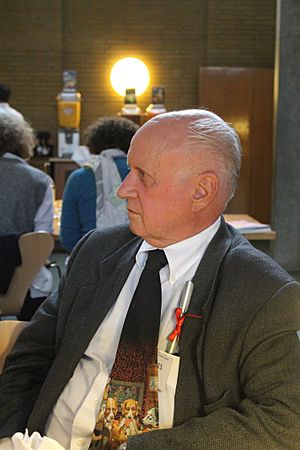
The 1994 theme was Going Today: Gone Tomorrow? Endangered Foods and Dishes. This focused on foods and dishes that might disappear. June di Schino discussed and shared samples of old monastic sweets from southern Italy. A very authentic Mexican meal was served, featuring special ingredients flown in from Mexico. Jeremy Cherfas talked about "Vanishing Vegetable Varieties -- and How to Save Them." Cherry Ripe, an Australian food journalist, gave a talk called "Dying of Starvation in the Supermarket," discussing how fewer types of plants and animals are being used for food. She pointed out that for many animal breeds to survive, they need to be eaten by humans.
The 1995 Symposium, Cooks and Other People, was the last to have a "do-it-yourself" lunch where attendees brought unusual foods. This was stopped due to new hygiene rules. The lunch did feature amazing desserts, like instant ice cream made with liquid nitrogen and a very expensive sorbet made with Château d'Yquem wine. The 1996 theme was Food on the Move. Claudia Roden spoke about "Food in the Sephardi diaspora," and Helen M. Leach traced the history of the pavlova dessert.
Fish: Food from the Waters was the 1997 Symposium theme. Ken Albala spoke about "Fish in Renaissance Dietary Theory," and Andrew F. Smith looked at the links between garum (an ancient Roman fish sauce) and ketchup. Harold McGee discussed slippery fish like snake mackerel. Nicholas Kurti talked about freshwater fish like carp and pike that were common in his childhood in Hungary.
Food in the Arts, the 1998 topic, covered many art forms. Joan Alcock surveyed food in detective novels, focusing on the gourmand detective Maigret. Barbara Haber discussed food in American films, and Andrew Coe spoke about food in Santería (a religion). Papers on painting included Robert Irwin's "The Disgusting Dinners of Salvador Dalí" and Gillian Riley's study of still life paintings by Luis Meléndez. The 1999 Symposium focused on Milk: Its Uses, Products and Substitutes. Ove Fosså explored the true age of Norwegian gamalost cheese, and Carolin Young revisited Marie Antoinette's dairy at Rambouillet.
Symposia 2000-2005: Memory, Meals, and Wild Food
The 2000 Symposium theme was Food and Memory. Rose Arnold spoke about Marcel Proust and his famous madeleine cake, which brought back memories for him. Andrew Dalby looked at meals in Suetonius's Lives of the Caesars and how they related to collective memory. Andrew F. Smith talked about "False Memories: the invention of culinary fakelore and food fallacies."
The 2001 Symposium theme was The Meal. Philip Iddison shared his experiences with "Perpetual Picnics: the meal in the UAE." Sami Zubaida focused on the Islamic world with "Drink in the Structure of the Meal: Middle Eastern patterns." The 2002 topic was Fat. Gerald and Valerie Mars discussed "Fat in the Victorian Kitchen: a medium for cooking, control, deviance and crime." Regina Sexton spoke about butter in the diet of monks in medieval Ireland.
The 2003 theme was Nurture. This was the last Symposium attended by Alan Davidson, who started the whole series in 1979. He had just won the Erasmus Prize, a major award, and this was celebrated at a special lunch. The book from this Symposium was the first edited by Richard Hosking, an expert in Japanese food. Until 2003, the Symposia were at St Antony's College. In 2004, they moved to Oxford Brookes University. The theme there was Wild Food. In 2005, the topic was Authenticity in the Kitchen.
The current chair of The Oxford Symposium is Elisabeth Luard. The President is Claudia Roden. The Director is Ursula Heinzelmann. The Patron is Theodore Zeldin.
Recent Symposia at St Catherine's College (2006-2020)
Since 2006, the Oxford Food Symposium has been held at St Catherine's College. Here are some of the themes:
- 2006: Eggs in Cookery
- 2007: Food and Morality
- 2008: Vegetables
- 2009: Food and Language
- 2010: Cured, Fermented and Smoked Foods
- 2011: Celebration
- 2012: Wrapped & Stuffed Foods
- 2013: Food & Material Culture
- 2014: Food & Markets
- 2015: Food and Communication
- 2016: Offal: Rejected and Reclaimed Foods
- 2017: Food and Landscape
- 2018: Seeds
- 2019: Food and Power
- 2020: Herbs and Spices
Many new ideas have been discussed for the first time at the Oxford Symposium, including the term "molecular gastronomy," which is about the science behind cooking.
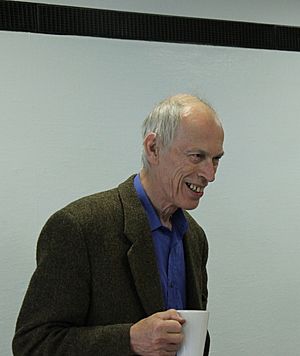
Published Symposium Books
The discussions from the Oxford Symposium are published in yearly books. These books are a great resource for anyone interested in food history and culture. Here are some of the published volumes:
- 1981: National & Regional Styles of Cookery
- 1983: Food in Motion: the Migration of Foodstuffs and Cookery Techniques
- 1984-1985: Cookery: Science, Lore & Books
- 1986: The Cooking Medium
- 1987: Taste
- 1988: The Cooking Pot
- 1989: Staple Foods
- 1990: Feasting and Fasting
- 1991: Public Eating
- 1992: Spicing Up the Palate: studies of flavourings, ancient and modern
- 1993: Look & Feel
- 1994: Disappearing Foods
- 1995: Cooks & Other People
- 1996: Food on the Move
- 1997: Fish: Food from the Waters
- 1998: Food in the Arts
- 1999: Milk: Beyond the Dairy
- 2000: Food and the Memory
- 2001: The Meal
- 2002: The Fat of the Land
- 2003: Nurture
- 2004: Wild Food
- 2005: Authenticity in the Kitchen
- 2006: Eggs in Cookery
- 2007: Food and Morality
- 2008: Vegetables
- 2009: Food and Language
- 2010: Cured, Fermented and Smoked Foods
- 2011: Celebration
- 2012: Wrapped & Stuffed Foods
- 2013: Food & Material Culture
- 2014: Food & Markets
- 2015: Food and Communication
- 2016: Offal: Rejected and Reclaimed Food
- 2017: Food and the Landscape
- 2018: Seeds
- 2019: Food and Power
- 2020: Herbs & Spices
- 2021: Food & Imagination
- 2022: Portable Foods: Food away from the Table
- 2023: Food Rules & Rituals


